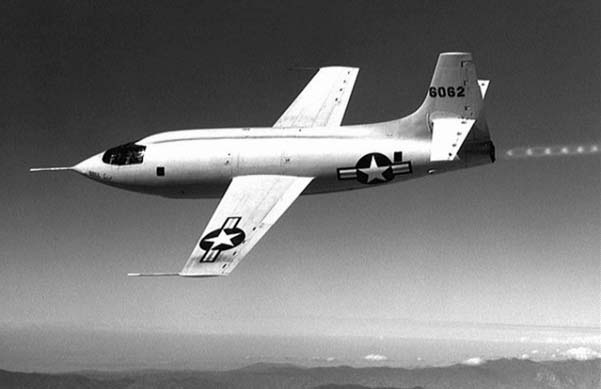
Sixty-two years ago this month, the legendary USAF/Bell XS-1 experimental aircraft exceeded the speed of sound when it reached a maximum speed of 700 mph (Mach 1.06) at 45,000 feet.
Bell Aircraft Corporation of Buffalo, New York built three copies of the XS-1 under contract to the United States Army Air Forces (USAAF). The aircraft were designed to approach and then fly beyond the speed of sound.
The Bell XS-1 was 31-feet in length and had a wing span of 28 feet. Gross take-off weight was around 12,500 lbs. The aircraft had an empty weight of about 7,000 lbs. Propulsion was provided by a Reaction Motors XLR-11 rocket motor capable of generating a maximum thrust of 6,000 lbs.
On the morning of Tuesday, 14 October 1947, the XS-1 (S/N 46-062) dropped away from its B-29 mothership (S/N 45-21800 ) as the pair flew at 220 mph and 20,000 feet. In the XS-1 cockpit was USAAF Captain and World War II ace Charles E. Yeager. The young test pilot had named the aircraft Glamorous Glennis in honor of his wife.
Following drop, Yeager sequentially-lit all four XLR-11 rocket chambers during a climb and push-over that ultimately brought him to level flight around 45,000 feet. The resulting acceleration profile propelled the XS-1 slightly beyond Mach 1 for about 20 seconds. Yeager then shutdown the rocket, decelerated to subsonic speeds, and landed the XS-1 on Muroc Dry Lake at Muroc Army Airfield, California.
The world would not find out about the daring exploits of 14 October 1947 until December of the same year. As it was, the announcement came from a trade magazine that even today is sometimes referred to as “Aviation Leak”.
Today, Glamorous Glennis is prominently displayed in the Milestones of Flight hall of the National Air and Space Museum located in Washington, DC. For his efforts in breaking the sound barrier, Chuck Yeager was a co-recipient of the 1948 Collier Trophy.

Comments
Dear Mr. White:
I really appreciate your efforts in documenting the many events that have shaped our aerospace effort. To really be effective, one must understand the building blocks we are attempting to build upon. Regarding the XS-1 story, it is interesting how a simple approach was used by Mr. John Stack of the NACA (fellow Collier recipient), to configure that first successful supersonic aircraft. The nose of this plane was certainly a “bullet” shape, being patterned after the Browning 50 cal projectile which was known to be stable (accurate) at supersonic velocity. Mr. Stack went on to make further history in being able to design a wind tunnel configuration in which aerodynamic tests could be accomplished at transonic speeds. All in the late 1940’s/early ’50’s. These early transonic and supersonic flight tests were done without the benefit of being able to do configuration tests in a wind tunnel, as is possible now, due largley to Mr. Stack’s work.
Keep up the good work.
Share this post: